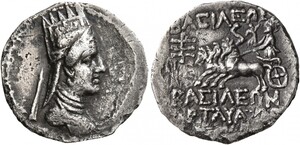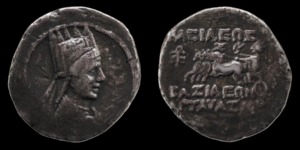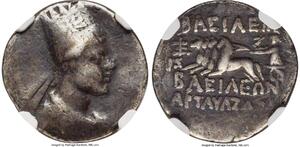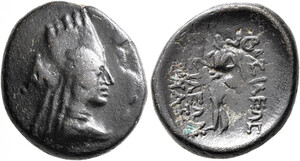Artavasdes II 56-34 BC (Kov 159-168)
Description
Artavasdes (BNP [3]) was the son of Tigranes II and his second wife, Cleopatra, daughter of Mithradates VI of Pontus. As successor to his father's kingdom Artavasdes was logically at first an ally of Rome, aiding Crassus in his Parthian campaign. However, Parthia attacked Armenia and Artavasdes switched sides, sealing the new alliance by giving his sister in marriage to Pacorus, crown prince and son of Orodes II (57-38 BC). In 38 BC Mark Antony set out to capture Parthia, at which point he sent his general, Canidius, to Armenia to induce Artavasdes to help Rome. Artavasdes was quarrelling with the king of Media (also named Artavasdes) so agreed to help Antony. But Antony's Parthian campaign ended in Media, never reaching Parthian soil. Antony blamed Artavasdes for his failure. In 34 BC Antony invaded Armenia, captured Artavasdes, and removed him to Alexandria. Artavasdes was held until after the battle of Actium, then executed.
Most of Artavasdes's coins are dated and can be correlated with the events of his turbulent reign. His first issue seems to have been struck in haste, employing obverse dies of his father Tigranes II. The reverse legends are faulty with misspellings of Artavasdes's name. The coins, two and one chalkous pieces, are dated year 1 and from the mint of Artaxata.
Artavasdes must have departed Armenia for the safety of the Parthian court almost immediately after advising the ill-fated Crassus, as there is a four year hiatus in the royal coinage at Artaxata. During this time dated autonomous coins were struck (see nos. 209-216). In 51/50 BC Artavasdes issued a drachm and a tetrachalkon dated to his year 6, followed in 50/49 BC by a drachm dated year 7.
After a ten year gap coinage is resumed with an issue of silver tetradrachms and drachms dated year 17 (40/39 BC) and tetradrachms of year 18 (39/8 BC). On these tetradrachms Artavasdes adds the epithet theios "divine" referring to his descent from the god Tigranes I, who was deified by his father Tigranes II. (See Kov-54-59). Why Artavasdes decided to make a point of his divinity after not doing so for the first sixteen years is an interesting question. His Parthian contemporary, Orodes II, did not employ the title on his coins (Sellwood types 42, 43, and 45- 48). However, Antony's colleague, Octavian had begun referring to himself as "son of the Divine Julius" on his coins (Crawford 525/2; Kienast 1990, 61), so perhaps Artavasdes felt that his own claim was now politically necessary.
The final issue is of undated bronze four and two chalkoi. These continue the types standardized during the reign of Tigranes II with the reverse types Nike advancing left (four chalkoi) and cypress tree (two chalkoi). These late bronzes are mostly, if not always, struck over foreign coins, and may be an emergency issue struck during Antony's invasion in 34 BC. Artavasdes's son and successor, Artaxias II, struck four chalkoi in his own name, likewise undated and over foreign coins. (see kov-169). All known coins of Artavasdes II are from the mint of Artaxata with the possible exception of Kov-167-168, which may have been struck at a mint moving with Artavasdes.
Kovacs, Frank L. “Armenian Coinage in the Classical Period” CNS 10, Classical Numismatic Group, Lancaster, 2016, pp. 25-26.
Most of Artavasdes's coins are dated and can be correlated with the events of his turbulent reign. His first issue seems to have been struck in haste, employing obverse dies of his father Tigranes II. The reverse legends are faulty with misspellings of Artavasdes's name. The coins, two and one chalkous pieces, are dated year 1 and from the mint of Artaxata.
Artavasdes must have departed Armenia for the safety of the Parthian court almost immediately after advising the ill-fated Crassus, as there is a four year hiatus in the royal coinage at Artaxata. During this time dated autonomous coins were struck (see nos. 209-216). In 51/50 BC Artavasdes issued a drachm and a tetrachalkon dated to his year 6, followed in 50/49 BC by a drachm dated year 7.
After a ten year gap coinage is resumed with an issue of silver tetradrachms and drachms dated year 17 (40/39 BC) and tetradrachms of year 18 (39/8 BC). On these tetradrachms Artavasdes adds the epithet theios "divine" referring to his descent from the god Tigranes I, who was deified by his father Tigranes II. (See Kov-54-59). Why Artavasdes decided to make a point of his divinity after not doing so for the first sixteen years is an interesting question. His Parthian contemporary, Orodes II, did not employ the title on his coins (Sellwood types 42, 43, and 45- 48). However, Antony's colleague, Octavian had begun referring to himself as "son of the Divine Julius" on his coins (Crawford 525/2; Kienast 1990, 61), so perhaps Artavasdes felt that his own claim was now politically necessary.
The final issue is of undated bronze four and two chalkoi. These continue the types standardized during the reign of Tigranes II with the reverse types Nike advancing left (four chalkoi) and cypress tree (two chalkoi). These late bronzes are mostly, if not always, struck over foreign coins, and may be an emergency issue struck during Antony's invasion in 34 BC. Artavasdes's son and successor, Artaxias II, struck four chalkoi in his own name, likewise undated and over foreign coins. (see kov-169). All known coins of Artavasdes II are from the mint of Artaxata with the possible exception of Kov-167-168, which may have been struck at a mint moving with Artavasdes.
Kovacs, Frank L. “Armenian Coinage in the Classical Period” CNS 10, Classical Numismatic Group, Lancaster, 2016, pp. 25-26.
Collection Tree
- ANCIENT
- Armenia Major
- Artavasdes II 56-34 BC (Kov 159-168)
- Armenia Major










